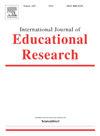Cultural identity in the arabic language textbooks of arab elementary schools in Israel
IF 2.6
3区 教育学
Q1 EDUCATION & EDUCATIONAL RESEARCH
引用次数: 0
Abstract
How is cultural identity reflected in elementary schools’ Arabic language textbooks in the Arab education system in Israel? The research describes and analyzes cultural identity representation in nine textbooks from the ’Al-‘arabiyya Luġatunā’ (Arabic Our Language) series for four distinct cultural groups: Palestinian-Arab (local), broader Arab, Jewish, and foreign cultures. Mixed methods qualitative and quantitative research, employed content analysis, examining the textbooks’ textual and visual dimensions. A specially-developed tool examined 16 cultural categories. Imbalance appeared in the four cultures’ representation in the textbooks. Although broader Arab culture was represented more than Palestinian-Arab culture, Palestinian-Arab representation was impressive. Jewish (majority) culture was surprisingly scantily represented, requiring further examination. Contrastingly, foreign cultures were strongly represented. However, Arab identity, particularly Palestinian, was represented superficially, ignoring Palestinian students’ needs as a cultural-religious-national minority group. These findings indicate that Israeli education policymakers do not see language as a central component in cultivating Palestinian Arab students’ cultural identity.
求助全文
约1分钟内获得全文
求助全文
来源期刊

International Journal of Educational Research
EDUCATION & EDUCATIONAL RESEARCH-
CiteScore
6.20
自引率
3.10%
发文量
141
审稿时长
21 days
期刊介绍:
The International Journal of Educational Research publishes regular papers and special issues on specific topics of interest to international audiences of educational researchers. Examples of recent Special Issues published in the journal illustrate the breadth of topics that have be included in the journal: Students Perspectives on Learning Environments, Social, Motivational and Emotional Aspects of Learning Disabilities, Epistemological Beliefs and Domain, Analyzing Mathematics Classroom Cultures and Practices, and Music Education: A site for collaborative creativity.
 求助内容:
求助内容: 应助结果提醒方式:
应助结果提醒方式:


